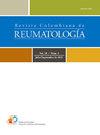Prevalencia de malestares musculoesqueléticos y enfermedades reumáticas en una comunidad indígena misak colombiana: estudio transversal con metodología COPCORD
Q3 Health Professions
引用次数: 0
Abstract
Introduction
Rheumatic diseases are a frequent cause of disability, deterioration in quality of life, and high health costs.
Objective
The objective of the study was to estimate the prevalence of rheumatic diseases using COPCORD methodology in the indigenous misak people of the Guambia - Cauca reservation, over 18 years of age.
Materials and methods
A community-based cross-sectional study was carried out using systematic random sampling, in 3 stages: 1. selection of participants house by house following the main rural road of each village of the Guambia reservation. 2. Application of the COPCORD questionnaire, Spanish version or version adapted and validated to Wam, misak language), by standardized bilingual interviewers. 3. Confirmation of the diagnosis was made by rheumatologists with access to all the information. Descriptive statistics were performed.
Results
Of a total of 624 people surveyed, 67% were women, the average age was 44 years, 49.2% had basic primary education, and 79.4% spoke Spanish. Pain in the last 7 days and/or history was reported in 366 respondents (58.6%). One hundred and ninety-two patients received medical evaluation, of which 27 (4.33%) had a diagnosis of rheumatic disease and particularly 21 (3.36%) of rheumatoid arthritis.
Conclusion
The prevalence of rheumatic diseases was lower than reported, however the prevalence of rheumatoid arthritis (3.36%) was higher than that reported in the rest of the country and in other Indigenous communities in Latin America. Rheumatic diseases represent a public health problem and specific information on Indigenous groups is necessary for the design of specific interventions.
哥伦比亚米萨克土著社区肌肉骨骼疾病和风湿病的流行情况:采用COPCORD方法进行的横断面研究
风湿性疾病是导致残疾、生活质量下降和高医疗成本的常见原因。目的本研究的目的是利用COPCORD方法估计18岁以上的瓜比亚-考卡保留地土著misak人风湿病的患病率。材料与方法采用系统随机抽样的方法,在社区开展横断面研究,分为3个阶段:在关ambia保留区每个村庄的主要乡村道路上逐个房屋选择参与者。2. 标准化双语采访者使用COPCORD问卷,西班牙文或经修改和验证的文(misak语)。3. 获得所有信息的风湿病学家确认了诊断。进行描述性统计。结果在624名被调查者中,67%为女性,平均年龄44岁,49.2%受过基础小学教育,79.4%会说西班牙语。366名受访者(58.6%)报告了过去7天和/或既往疼痛。192例患者接受医学评估,其中27例(4.33%)诊断为风湿性疾病,其中21例(3.36%)诊断为类风湿关节炎。结论该地区风湿性疾病患病率低于报告,但类风湿关节炎患病率(3.36%)高于全国其他地区和拉丁美洲其他土著社区的报告。风湿病是一个公共健康问题,关于土著群体的具体信息对于设计具体的干预措施是必要的。
本文章由计算机程序翻译,如有差异,请以英文原文为准。
求助全文
约1分钟内获得全文
求助全文
来源期刊

Revista Colombiana de Reumatologia
Medicine-Rheumatology
CiteScore
0.80
自引率
0.00%
发文量
92
期刊介绍:
The Colombian Journal of Rheumatology (Revista Colombiana de Reumatología) is the official organ of the Colombian Association of Rheumatology (Asociación Colombiana de Reumatología) and the Central American, Caribbean and Andean Association of Rheumatology (Asociación Centroamericana Caribe Andina de Reumatología) - ACCA. It was created in December 1993 with the purpose of disseminating scientific information derived from primary and secondary research and presenting cases coming from the practice of Rheumatology in Latin America. Since its foundation, the Journal has been characterized by its plurality with subjects of all rheumatic and osteomuscular pathologies, in the form of original articles, historical articles, economic evaluations, and articles of reflection and education in Medicine. It covers an extensive area of topics ranging from the broad spectrum of the clinical aspects of rheumatology and related areas in autoimmunity (both in pediatric and adult pathologies), to aspects of basic sciences. It is an academic tool for the different members of the academic and scientific community at their different levels of training, from undergraduate to post-doctoral degrees, managing to integrate all actors inter and trans disciplinarily. It is intended for rheumatologists, general internists, specialists in related areas, and general practitioners in the country and abroad. It has become an important space in the work of all rheumatologists from Central and South America.
 求助内容:
求助内容: 应助结果提醒方式:
应助结果提醒方式:


